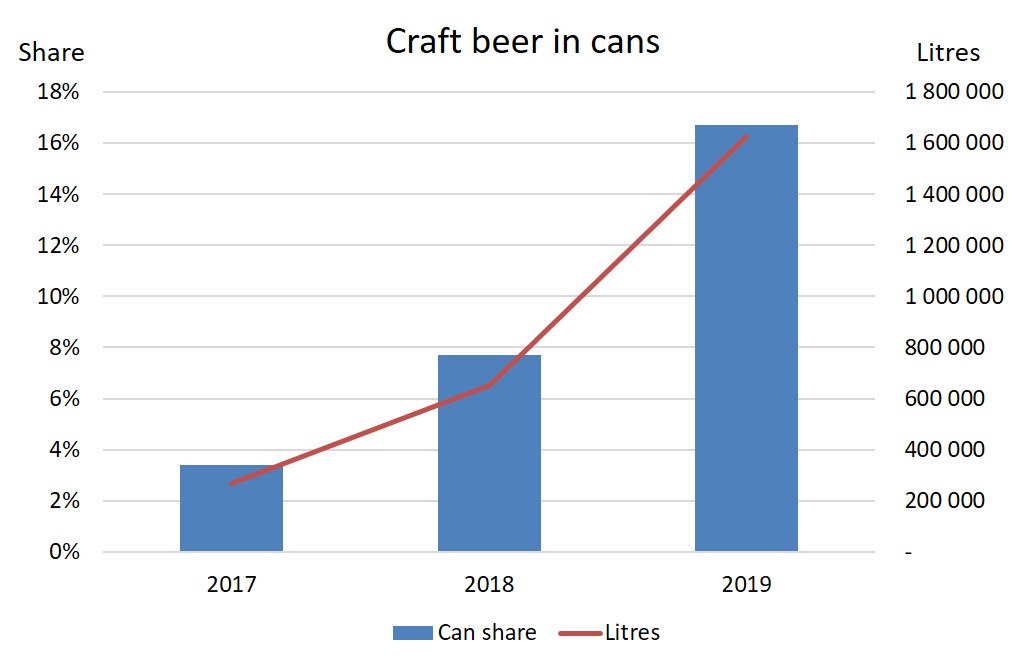What is it with craft beer and cans? I have noticed an increased interest in beverage cans from the local craft brewers, or microbeweries, here in Sweden.
One after the other launch new products in beer cans, not in glass bottles. Glass bottles used to be the standard for this premium beer segment.
The craft brewing scene is booming also in Sweden with a big number of small brewers and glass bottles are the dominating pack type. Glass bottles represents tradition and premium, two of the impressions that you as a craft brewer work really hard to convey to your consumers.
When you are selling a product at a price three times above your industrial brewing competitors, you have to work hard on your image. But something is happening…
The power of glass
The beverage can is in many consumer’s eyes a packaging used for mass production that does not necessary contain very sophisticated brews.
The craft brewers have mostly been true to glass bottles for their precious drops, and that for a few sound reasons.

- A craft brewer with self-respect have a large number of creative varieties of beer available and need flexibility in production. To use only one container and vary the label is efficient in a low volume production of several product varieties.
- It is also cost effective as you can get away with rather basic equipment when filling bottles on a small scale. And it is often also simply impossible for a small brewer to purchase the amounts of decorated cans needed to reach the lowest order level.
- Last but not least, the positioning of the product. Glass stands for quality, premium and tradition. These are images you very much want to reflect on your craft brew.
Incredible growth
Most of the above is still valid but the trend is clearly towards using more cans for the most premium products and for very small product batches.
The numbers speak for themselves, in 2019 the volume craft beer in cans increased by 2.5 times, for the second year in a row!
An increase from 8% of the craft beer volume to 17% in three years. In 2017, 12 brewers made 35 beer products available in cans. In 2019 70 brewers offered more than 400 products in cans. That’s an improvement!

Why is this?
The trend is clear and seems unstoppable. The movement is founded on a few obvious facts and some a bit more hazy.
* Some of the craft brewers have simply expanded their markets and volumes and are ready to invest in cans and a can filling line.
* Others have managed to get one single and specific product on a national distribution and can take the leap with that one product.
* Some who not yet have those volumes use blank cans and attach a unique label to maintain the flexibility.
Then it helps that the suppliers of cans have spotted the opportunity in craft beer and are lowering the bar for the smallest order.
Finally, but not least, consumers appreciate the product.

Environment and quality
All brewers I have heard comment on this argue the environmental benefits and the improved quality of the product. A sealed can is an airtight space and it is completely dark inside which maintains the quality. A can is easily recycled in this country with an efficient deposit scheme in place. As a matter of fact, 85% of the distributed cans are returned and recycled.
Marketing by packaging
They just do it! And they do it within the very narrow space that is left due to the current and very strict regulations around all alcohol promotion.
They build their brand using the means that are available, except from the product itself what is left is basically, the website, the shop and the bar.
At the point of sales there is nothing else you can use than the packaging itself. This is a clean case of marketing by packaging. The pack type, size, design and decoration are key to positioning and sales of a beer product in this market.

They utilize the packaging very well with brilliant graphic design, creative fonts and inspirational product names. And of course, a great product with a high and stable quality is very helpful when you want to convince consumers.
An inspiring industry
This is a small scale industry with very limited resources that is constrained by square and rigid laws. They have still managed to turn the opinion and make something considered as a very basic packaging into a premium container. And successfully claiming a price three times the “normal”.
This is quite an achievement and well worth to celebrate. Why not with an unfiltered, hoppy and hazy beer? From a can, plenty to choose from…


